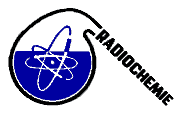Speaker
Ms
Anne Heller
(Forschungszentrum Dresden-Rossendorf, Institute of Radiochemistry)
Description
Due to their radiation and heavy metal properties, radionuclides represent a serious health risk to humans in case of incorporation. To understand their toxicity, transport, deposition and elimination in the human organism, it is therefore crucial to elucidate their chemical behavior and properties on a molecular level. For trivalent actinides originating from nuclear power plants knowledge about their metabolism is very limited. In case of incorporation, they tend to accumulate in liver and skeleton and are excreted to maximum 10 – 20 % within the first week. Nevertheless this excretion occurs mainly through the kidneys, which are known to be particularly radiation sensitive.
To address the lack of knowledge, we studied the speciation of curium (as a representative of trivalent actinides) and europium (as the lanthanide analogue) in human urine and their complexation with single constituents. Since both of these heavy metals exhibit unique fluorescence properties, time-resolved laser-induced fluorescence spectroscopy (TRLFS) is an adequate tool for this purpose.
Fresh 24-hours-urine samples were collected from healthy volunteers and analyzed within few days. The inorganic composition of all samples was determined using mass spectrometry with inductive coupled plasma (ICP-MS) and ion chromatography (IC). Then all samples were spiked in vitro with curium or europium and single as well as time-resolved laser-induced fluorescence spectra were measured. We analyzed at least 10 different urine samples and were able to divide all samples into two different groups according to their fluorescence spectra.
We found that all samples with a pH below 5.6 and all samples with a pH above 6.0 each exhibit strikingly similar spectra. Compared to each other the spectra of both groups are very different and therefore easy to distinguish. Furthermore the lifetime of the metals in samples with higher pH is substantially longer than in samples with lower pH. ICP-MS and IC analysis revealed that the inorganic composition of samples which exhibit the same fluorescence spectra can vary broadly within magnitudes. Therefore the most important factor influencing the speciation of metals in human urine does not seem to be the composition but was determined to be the pH.
To identify the dominating species we also recorded the fluorescence spectra of both metals in electrolyte solution containing all inorganic but no organic components of urine. Furthermore we studied the complexation of both metals with urea and citric acid as main organic urine constituents. Comparing the measured spectra and lifetimes with this reference data, we found that at lower pH a complex citric acid species dominates the speciation of both metals while at higher pH the spectra where identical to those in electrolyte solution ruling out any involvement of organic ligands. The exact nature of this inorganic metal species has yet to be clarified.
Primary author
Ms
Anne Heller
(Forschungszentrum Dresden-Rossendorf, Institute of Radiochemistry)
Co-authors
Dr
Astrid Barkleit
(Forschungszentrum Dresden-Rossendorf, Institute of Radiochemistry)
Prof.
Gert Bernhard
(Forschungszentrum Dresden-Rossendorf, Institute of Radiochemistry)

